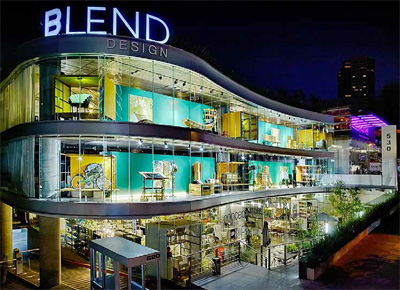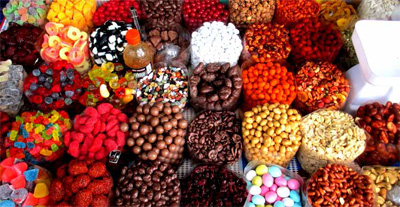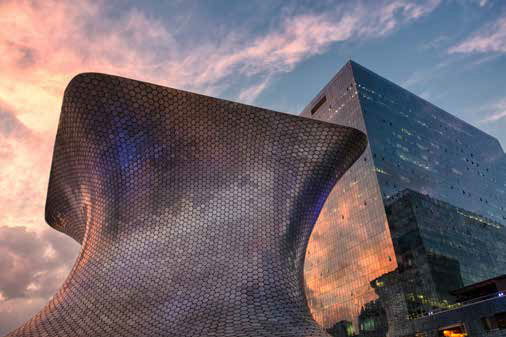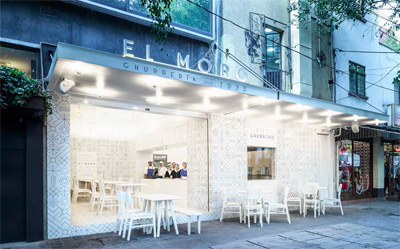BY 7 A.M. ON WEEKDAY MORNINGS, most of the 22 million residents in the vast and densely packed Mexico City metropolitan area are on the move, commuting to work on crowded buses, Metro trains and suburban rail lines. Every day about 10 million personal vehicles cram the highways and side streets and, if the sky is not too smoggy, wealthy executives fly to work in private helicopters, landing on the rooftop helipads of downtown skyscrapers.
Although known for its cultural institutions and more recently for its modern architecture — named World Design Capital 2018 by the International Council of Societies of Industrial Design — this sprawling metropolis remains a working-class city. An economic giant with a gross domestic product of more than $415 billion, it is one of the largest urban areas in the world based on economic output, accounting for about 22 percent of Mexico’s total national GDP. If Mexico City were a country, it would be the fifth-largest economy in Latin America, five times as large as Costa Rica’s and about the same size as Peru’s.
The oldest capital city in the Americas, built in 1325 by the Aztecs on an island in ancient Lake Texcoco and occupied by Spain in the 1500s, it continues to evolve, even changing its official name last year. Known for two centuries within Mexico as DF (Distrito Federal, or Federal District), now the area of nearly 9 million residents within city limits is officially Ciudad de Mexico, or CDMX for short.
CDMX is experiencing a business and tourism boom largely due to its strengthening urban economy, a worldwide interest in Mexican interior design and architecture, and the revitalization of city neighborhoods, or colonias. In recent years, as the city police force grew to almost 90,000, crime decreased considerably, especially the drug-related violence that once plagued the region, resulting in record numbers of visitors. Almost 30 million tourists arrived in 2016, an increase of almost 2 percent over 2015, also a record-breaking year, according to Miguel Torruco Marqués, director of tourism. Tourists staying in hotels in Mexico City in 2016 resulted in an economic impact of around $3.85 billion, 6 percent more than in 2015.
Under Mayor Miguel Ángel Mancera, the city constructed new parks, improved industrial technology, started a strict biannual vehicle emission inspection program and began the reformulation of gasoline and diesel fuels. The Metrobús rapid transit and the Ecobici bike-sharing program contribute to efforts to encourage alternate, greener forms of transportation.
Last December Mexico City hosted the sixth biennial C40 Mayors Summit, bringing together mayors, sustainability leaders and Fortune 500 executives from mega-cities all over the world. “It is no secret that in Mexico City we grapple with the twin problems of air pollution and traffic,” said Mayor Mancera to the large gathering at the Hilton Mexico City Reforma Hotel. “By expanding alternative transportation options, like our Bus Rapid Transport and subway systems, while also investing in cycling infrastructure, we are working to ease congestion in our roadways and our lungs.”
Mexico’s political leaders, including President Enrique Peña Nieto as well as Mexican and American multinational firms with offices, plants and distribution networks in both countries, are troubled about the future business relationship between the United States and Mexico under the Trump administration. This was evident during my visit just after the U.S. election, when local business leaders expressed concern about how the new U.S. political landscape will affect Mexico’s burgeoning but still fragile economy, their concerns magnified when the value of the Mexican peso went into freefall immediately following the vote.
Right now, however, Mexico City is on a roll. Many of the buildings in El Centro, the historic center, have been beautifully restored. Pedestrian shopping streets have been created, and an army of street sweepers keep the district spotlessly clean. In the past several decades as Mexico City grew, its wealthy residents moved westward, building lavish homes in Polanco, Lomas de Chapultepec and Bosques de las Lomas, and more recently in Santa Fe, a distant but fast-growing business center. Santa Fe houses corporate office towers, luxury business hotels and Centro Santa Fe, the largest retail mall in Latin America. JW Marriott, Hilton, Westin, NH Collection and InterContinental operate properties here, and a new AC Hotel Santa Fe will open this year. The Mexican stock exchange, Bolsa Mexicana de Valores, is located here, as well as an expanding residential district and three college campuses, all part of this surreal-looking edge city 12 miles west of downtown.

Blend Design concept store with designer products © ARACELI PAZ
In Polanco high-end hotels, restaurants and residential mansions prospered for decades, and the newer Nuevo Polanco neighborhood now flourishes with development projects. Polanco’s Avenida Presidente Masaryk, with its exclusive fashion boutiques, jewelers, banks and high-end restaurants, resembles Beverly Hills’ Rodeo Drive. The Condesa and Roma Norte neighborhoods, perhaps the trendiest districts close to downtown, offer restaurants with valet parking, music clubs, late-night bars and, yes, irritating weekend traffic jams. The area entices visitors with renovated Spanish colonial buildings; lush parks with sculptured fountains; and design-driven cafés, bars, hotels and small office buildings.
Even closer to downtown’s Reforma business district, La Juárez boasts new bars, art galleries, restaurants and shops, and the new Stara Hamburgo Hotel attracts an upscale clientele. San Rafael lies close to Reforma but maintains a residential calm and offers small theaters, cafés and restaurants. About six miles south of El Centro’s huge Zócalo — the largest public square in the Western Hemisphere — sits Coyoacán, a large, fashionable district containing mini-neighborhoods, each with its own diverse eateries and shops.

Sweet treats at a food stand © RON BERNTHAL
Of course, not every Mexico City neighborhood offers a tree-lined sanctuary of peace and quiet. Most are working-class districts with few upscale amenities. Cars and trucks clutter their narrow streets, and food carts line the sidewalks offering pastries, sandwiches (tortas), dozens of taco varieties, salads, sweets and drinks from early morning to evening. If you choose carefully, you can enjoy a quick and delicious food cart breakfast, lunch or snack for $1–2.
Things to Do in Mexico City
While the phrase “Mexico’s Moment”— MeMo — is used to generate tourist interest in the entire country, the acronym can also apply to Mexico City’s cutting-edge architecture, as in “Mexico City Modern.” Although Mexican architects like Luis Barragán, Felix Candela and Pedro Ramirez defined the city’s great 20th-century buildings, international architects are contributing to its stunning new projects.

Museo Soumaya © MEXICO CITY TOURISM
Museo Jumex, an award-winning private art museum designed by British architect David Chipperfield, occupies a marble, stainless steel, concrete and glass structure. Opened in the Nuevo Polanco neighborhood in 2013, it offers rotating exhibitions, conferences and performances. The anvil-shaped Museo Soumaya stands across the street, presenting a striking windowless façade composed of 16,000 reflective, hexagonal aluminum tiles. A gift from Mexican billionaire Carlos Slim to his late wife, Soumaya Domit, and designed by his son-in-law, noted architect Fernando Romero, the museum showcases more than 6,000 pieces of Latin American art.
Although muralist Diego Rivera was born in Guanajuato, he spent most of his life in the capital, along with his larger-than-life marriages to the artist Frida Kahlo. View Rivera’s epic-sized murals in four locations within walking distance in the historic center. At the Palacio Nacional, a mural painted between 1929 and 1935 wraps around a wall and shows the history of Mexico in vibrant colors. At the nearby Secretaría de Educación Pública, a mural covers two levels of the interior courtyard; and the Museo Mural Diego Rivera houses one of his most famous murals, Dream of a Sunday Afternoon in Alameda Central Park, painted in 1947.
The Palacio de Bellas Artes displays Man, Controller of the Universe, which Rivera painted as a recreation of his Man at the Crossroads mural, commissioned by the Rockefeller family for Rockefeller Center in New York City. The Rockefellers destroyed the original mural in 1934 as Rivera was working on it because its subject matter related to the Soviet Union. The Palacio de Bellas Artes also contains murals by David Alfaro Siqueiros, José Clemente Orozco and Rufino Tamayo. You can visit Rivera and Kahlo’s studio and house, constructed in the 1930s in the San Ángel neighborhood.
Also visit the house and studio of Luis Barragán, a pioneer in Mexico City’s modern architecture movement. Casa Luis Barragán, constructed in 1948, became a UNESCO World Heritage site in 2004, the only individual property in Latin America to achieve the honor. Barragán’s influence in global architecture is well-known, and his house remains the way it was at his death in 1988.
CHECKING IN WITH DIEGO ITURBIDE
Manager, La Churrería El Moro, Mexico City
How long has La Churrería El Moro been in business?
My family has been selling churros in Mexico City since 1933, when my grandfather, Francisco Iriarte, arrived here from Elizondo, a small town in Spain. The business is named after the fiestas in these Spanish towns, where an Arab known as El Moro sold churros from town to town in a cart. When Francisco noticed they did not sell churros in Mexico, he started selling them from a cart in the Zócalo, and after two years he opened a small shop in the city center at Eje Central Lázaro Cárdenas 42, Cuauhtémoc — a place that is still in operation, 24 hours a day, seven days a week. Francisco died young, and his three brothers moved to Mexico to take care of the business, which has passed from generation to generation to become one of the great traditions in the Mexican capital.

La Churrería El Moro © EL MORO
What exactly is a churro?
Churros are a breakfast tradition in Mexico City. It is a thin, deep-fried dough stick dusted in sugar. It is crispy on the outside, warm and soft on the inside, and best dunked into a steaming cup of hot chocolate. We offer six styles of hot chocolate, ice cream and our amazing fresh churros.
Why did the company expand the business in recent years?
The family noticed that as many neighborhoods in Mexico City became more developed, with new restaurants and snack places opening, it was time to open additional El Moro outlets with a new store design. It was a big challenge to add four more stores and keep the artisanal, handmade tradition of making churros. We wanted to grow the concept and perhaps expand one day into other countries with our unique Mexican company. The Mexico City firm Cadena + Asociados, which created our new stores’ design, won first place in Restaurant Concept Design at the International Interior Design Association’s Best Interiors Latin America competition.
What changes do you see now in Mexico City?
I see with my own eyes the city is getting safer, and it is fantastic how many tourists we get year-round now. Mexico City is filled with new museums and parks, and there are many festivals every month which are suitable for a casual, fun place like El Moro. Many Mexican people are traveling more. They are making a better income, and their expectations are higher when it comes to the appearance of stores and restaurants. We are giving all the people a clean and friendly place to eat. We are always busy, and there is usually a line waiting for the fresh churros.
COMING AND GOING
All U.S. citizens, including children, need a valid passport and tourist card to enter Mexico. U.S. citizens arriving by cruise ship and visiting a port for a day do not need a passport. Business travelers must file a special form which authorizes business activities but not employment for 30 days. Purposes besides tourism and business or stays of more than 180 days require a visa and U.S. passport.
JUST THE FACTS
Time zone: GMT -6
Phone code: Country code: 52 City code: 55
Currency: Peso
Key industries: Banking, insurance, financial firms, architecture firms, construction, iron and steel, textiles, plastics, furniture, tourism and hospitality services, education and cultural attractions
OFFICIAL LANGUAGE
Spanish
Mexico City Info to Go
Benito Juárez International Airport (MEX) lies about 10 miles from the business district. Terminal 1 was remodeled in 2006 but is often crowded and chaotic. Terminal 2, used by Aeromexico and its SkyTeam carriers, opened in 2008 and is easier to navigate. Travel between the terminals requires taxi, shuttle bus or monorail. For late-night arrivals or early-morning departures, consider staying at NH Collection Airport T2 Hotel in Terminal 2. The British firm Foster+Partners and Mexico’s Fernando Romero Enterprise won the competition to design Mexico City’s new 5-million-square-foot, $9.2 billion, LEED Platinum airport, about three miles from the current airport. It will be one of the world’s largest airports when it opens in 2020.
Restaurants in Mexico City
CONTRAMAR Chef Andrés Barragán helms the seafood restaurant specializing in fresh tuna, shrimp and octopus, trucked daily from Mexico’s Pacific and Gulf coasts. Try the coconut flan and fig tart desserts. Lunch only; reserve early. Calle Durango 200, Colonia Roma, Cuauhtémoc $$–$$$
J BY JOSÉ ANDRÉS James Beard Outstanding Chef José Andrés’ first restaurant outside the United States integrates his legendary Spanish classics with Mexican favorites in a tantalizing small plates menu. Open daily for lunch and dinner. W Mexico City, Campos Elíseos 252, Polanco $$$–$$$$
LUNA BISTRO Excellent entrées by Chef Javier Ramirez include rack of lamb with mint gremolata and Kalamata tapenade, and crusted grouper Provençal plus innovative risottos, soups and salads. Open daily for lunch and dinner. Stara Hamburgo Hotel, Calle Hamburgo 32, La Juárez $$
Where to Stay in Mexico City
HABITA HOTEL Part of Grupo Habita and a member of Design Hotels, the 32-room, four-suite property occupies a frosted glass cube with a ground-floor restaurant, fifth-floor open-air swimming pool and trendy rooftop bar. Ave. Presidente Masaryk 201, Polanco $$$
HOTEL CARLOTA Redesigned by Mexico City’s JSa Arquitectura, the hotel boasts 36 rooms furnished by Mexican interior designers, a courtyard with a pool, a great bar and restaurant, friendly staff, WiFi and complimentary bicycles. Río Amazonas 73, Cuauhtémoc $$$–$$$$
STARA HAMBURGO HOTEL A member of Small Luxury Hotels of the World, the art-filled boutique hotel comprises two historic houses with original brick walls, 55 guestrooms with balconies, business center, roof garden restaurant and first-floor Luna Bistro. Calle Hamburgo 32, La Juárez $$$–$$$$
Read This Next

Introducing
FX Excursions
FX Excursions offers the chance for once-in-a-lifetime experiences in destinations around the world.
#globility
Insta FeedMarch 2025
Mar 30, 2025Enjoy the Flavors of Atlanta with a Side of History on a Food Excursion
With more than 50 million visitors a year, Atlanta proves popular for its attractions, entertainment options, history and culture. Boasting a thriving food scene, the city offers several James Beard award winners and Michelin-starred restaurants. An excellent way to get to know Atlanta and learn more about the city’s culinary scene and its history is to take a food tour.
Sponsored Content
Find Your Perfect Escape with Paradisus by Meliá — More Than Just All-Inclusive
Luxury travel today is about more than just beautiful accommodations — it’s about experiencing the destination. Paradisus by Meliá takes traditional all-inclusive resorts to the next level by offering indulgence with immersion, experiences and authenticity. Each resort is shaped by its location, local flavors and curated Destination Inclusive® experiences that bring you closer to the heart of the destination.
March 2025
Mar 29, 2025Adventures of All Kinds Await Amid the Biodiversity of Belize
Tucked between Mexico and Guatemala on Central America’s Caribbean coast, Belize, about the size of Massachusetts, is a small but bountiful country when it comes to natural beauty, adrenaline-pumping adventure and utter relaxation. Plenty of people set their sights on the destination’s subtropical climate, rich culture and history, and outdoor pursuits, too: Last year saw record-breaking numbers of visitors.
Daily
Mar 28, 2025Smithsonian in the Gap Exhibit Debuts in Buffalo Gap, Texas
This year marks the 150th anniversary of Buffalo Gap, Texas, and, to add to the celebrations, the town has been chosen as one of seven Texas destinations to host the Smithsonian Institute’s national exhibit, Crossroads: Change in Rural America. On view until April 27 in Buffalo Gap Historic Village, this exhibit provides powerful insight into how Buffalo Gap helped define the rural landscape of this part of Texas.
Sponsored Content
Madrid: The Charm of an Authentic City
They say Madrid is in vogue for many reasons: its lifestyle, its heritage, its cuisine and all of its new attractions. And it’s true, because Madrid is on the radar of travelers looking for a cutting-edge destination that still holds onto its essence. Join us as we explore its charms.
March 2025
Mar 28, 2025Keep on Track with Top-Notch Devices and Accessories
Sidetrak Solo Pro 13.3-Inch Touch Monitor Working on the move doesn’t have to impact your productivity, thanks to this touchscreen monitor from SideTrak. Weighing just 1.6 pounds and measuring only 0.5 inches thick, it’s easy to tuck into your bag while providing an extra 13.3-inch screen connected via USB-C or mini-HDMI. Effective for multitasking or even letting your family watch a movie while you get some work done, it’s a great addition to any travel kit. $264.99.
7 Penthouse Suites with Unforgettable Views
Daily
Mar 28, 20253 Idaho Hot Springs to Add to Your Travel List
Daily
Mar 28, 2025Tauck Unveils Names, Renderings of New Riverboats
Daily
Mar 27, 2025Daily
Mar 26, 2025The Luxury Collection Welcomes The Palace, a Luxury Collection Hotel, Madrid
The Luxury Collection officially welcomed The Palace, a Luxury Collection Hotel, Madrid into its global portfolio after its two-year restoration and refurbishment. The hotel, in Madrid’s Barrio de Las Letras, was formerly The Westin Palace, Madrid.
Sponsored Content
A Summer Sojourn Along Europe’s Rivers with AmaWaterways
This summer, elevate your vacation experience with award-winning AmaWaterways. Offering a seamless blend of unparalleled luxury, authentic cultural experiences and unrivaled service, AmaWaterways cruises are the perfect way to uncover the heart of Europe during the sunniest season with itineraries that glide along the continent’s most iconic rivers, including the Danube, the Rhine, the Seine and the Douro.
March 2025
Mar 26, 2025Head to Jackson Hole and Revel in the Remote Possibilities
For a city girl like me, stepping into the town square of Jackson, in northwest Wyoming, felt like walking onto a slicker set of the television show Gunsmoke. Wooden sawtooth facades surround Jackson’s Town Square (a.k.a. George Washington Memorial Park). Visitors stroll the boardwalk connecting the Western-style buildings, each with a large window displaying goods, restaurants and art galleries. Iconic arches, assembled with discarded elk antlers from nearby National Elk Refuge, perch on each corner of the town square. Stagecoaches pulled by teams of horses parade other city-dwellers around the park.
ShareThis